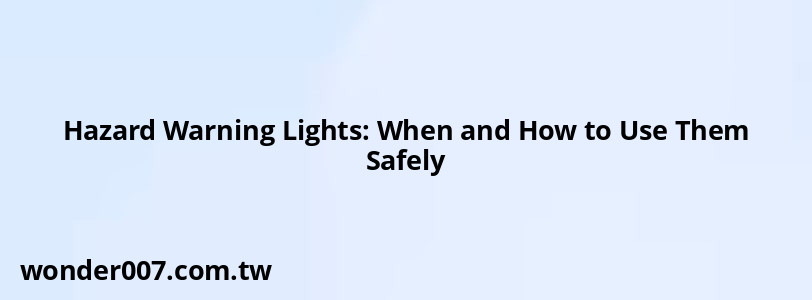Hazard Warning Lights: When and How to Use Them Safely

Hazard warning lights, commonly referred to as hazard lights or emergency flashers, are an essential safety feature in vehicles. They serve to alert other drivers of potential hazards or emergencies. Understanding when and how to use them is crucial for ensuring road safety.
When You Are Allowed to Use Hazard Warning Lights
Hazard lights should be used primarily in specific situations where your vehicle poses a risk to other road users. Here are the key instances:
- Stationary Vehicle Causing Obstruction: Activate your hazard lights if your vehicle has broken down or is stopped in a potentially dangerous location, such as the hard shoulder of a motorway or a busy road. This alerts other drivers to your presence and encourages them to navigate around you safely.
- Temporary Stops in Unexpected Places: If you need to stop temporarily in areas where stopping may not be anticipated (like a narrow or blind bend), turn on your hazard lights to indicate a potential hazard.
- Emergency Situations on Motorways: When driving on a motorway or unrestricted dual carriageway, you can briefly use your hazard lights to warn drivers behind you of an upcoming danger, such as a sudden traffic jam. This is especially important if you are moving slowly due to an unavoidable issue, like trying to reach a safe location after a breakdown.
- Roadside Emergencies: If you encounter roadside emergencies, such as changing a tire, turning on your hazard lights can help signal your need for caution from other drivers.
When You Should Not Use Hazard Warning Lights
Using hazard lights incorrectly can lead to confusion and unsafe driving conditions. Here are situations where you should avoid using them:
- Normal Driving Conditions: Do not use hazard lights while driving normally. They can mislead other drivers about your intentions since they disable the use of turn signals.
- Illegal Parking: Using hazard lights does not justify illegal parking or stopping in restricted areas. You may still receive fines or penalties for illegal parking even with your hazards on.
- Flashing Lights as Gratitude: Do not flash your hazard lights to thank other drivers; this can confuse others on the road and lead to misunderstandings about your actions.
- Driving in Poor Weather: Contrary to some beliefs, using hazard lights during heavy rain or fog is not advisable as it can confuse other drivers about your speed and direction.
Important Considerations
When using hazard warning lights:
- Ensure they are turned off once the situation no longer presents a hazard. Leaving them on unnecessarily can create confusion for other road users.
- Remember that while your hazard lights are activated, your turn signals will not function. This means that you cannot indicate turns or lane changes effectively while using them.
By understanding the proper use of hazard warning lights, you can enhance safety for yourself and others on the road. Always prioritize clear communication with other drivers through appropriate signaling methods.
Related Posts
-
Chevy Traverse Dash Lights: Troubleshooting Guide
29-01-2025 • 135 views -
BMW Warning Lights: How to Turn Them Off
29-01-2025 • 240 views -
John Deere 5085E: Understanding Warning Lights
26-01-2025 • 185 views -
Steering Assist Is Reduced: Understanding the Warning Message
26-01-2025 • 285 views -
Car Maintenance: What to Do When Your Oil is Low
28-01-2025 • 152 views
Latest Posts
-
2015 Chevy Traverse AC Recharge Port Location
01-02-2025 • 366 views -
Are O2 Sensors Covered Under Warranty
01-02-2025 • 339 views -
How To Turn Off Paddle Shifters Mercedes
01-02-2025 • 335 views -
Rear Brake Caliper Piston Won't Compress
01-02-2025 • 315 views -
Power Steering Fluid Leak On Passenger Side
01-02-2025 • 420 views
Popular Posts
-
V12 Engine Costs: What You Need to Know
26-01-2025 • 633 views -
Hino Warning Lights: Understanding Dashboard Alerts
26-01-2025 • 636 views -
EPC Warning Light: What It Means for Your Vehicle
27-01-2025 • 592 views -
EPC Light: Understanding Causes and Solutions
26-01-2025 • 1019 views -
Power Steering and ABS Light On: Causes and Solutions
27-01-2025 • 613 views
